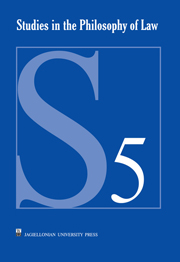Book contents
- Frontmatter
- Contents
- Preface
- I Legal Implications of Medical Advances
- 1 The Genomics Revolution in the Shadow of Auschwitz: Eugenics, Genism, and Genetic Genocide
- 2 Human Genetic Engineering and the Problems of Distributive Justice
- 3 Genetic Testing – Present and Future Problems
- 4 What Is So Unfair about Using Genetic Information? The Problem of Genetic Discrimination
- II Evolutionary Approach to the Normativity of Law
- III Appendix
- About the Authors
3 - Genetic Testing – Present and Future Problems
from I - Legal Implications of Medical Advances
Published online by Cambridge University Press: 05 September 2014
- Frontmatter
- Contents
- Preface
- I Legal Implications of Medical Advances
- 1 The Genomics Revolution in the Shadow of Auschwitz: Eugenics, Genism, and Genetic Genocide
- 2 Human Genetic Engineering and the Problems of Distributive Justice
- 3 Genetic Testing – Present and Future Problems
- 4 What Is So Unfair about Using Genetic Information? The Problem of Genetic Discrimination
- II Evolutionary Approach to the Normativity of Law
- III Appendix
- About the Authors
Summary
The sequencing of the human genome has produced a huge quantity of genetic data. Nowadays scientists concentrate on applying this new information to clinically useful purposes and therapies. Genetic tests are considered to be one of the first applications.
A genetic test is the analysis of human DNA, RNA, chromosomes, proteins and certain metabolites in order to detect heritable disease-related genotypes, mutations, phenotypes or karyotypes for clinical purposes. Depending on the test substance and the results that could be obtained, various testing methods are employed, namely:
a) direct testing: the direct study of genes (DNA sequences) and RNA; this method is used to detect the disease caused by an identified well-known mutation; these changes can be easily found and interpreted,
b) linkage testing (indirect testing): is used when the gene cannot be identified directly, but the region of chromosome is known; application of the method requires additional DNA testing of several relatives of the tested person, in order to find the presence of pathogenic changes (mutations) in the gene by identifying genetic markers of DNA that are inherited together with the tested genes,
c) biochemical testing: an examination of some metabolites, such as enzymes or proteins; enzymatic analysis measures the rate of chemical reaction in the presence of a protein that facilitates the reaction (enzyme); the activity of the enzyme is quantified in order to diagnose genetic disease;
[…]
- Type
- Chapter
- Information
- Studies in the Philosophy of LawLaw and Biology, pp. 45 - 52Publisher: Jagiellonian University PressPrint publication year: 2010



